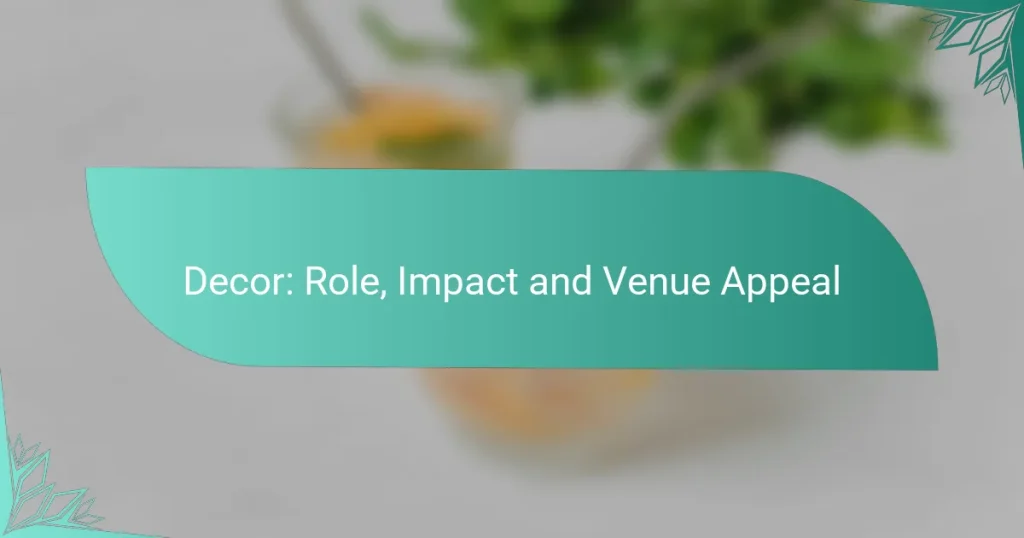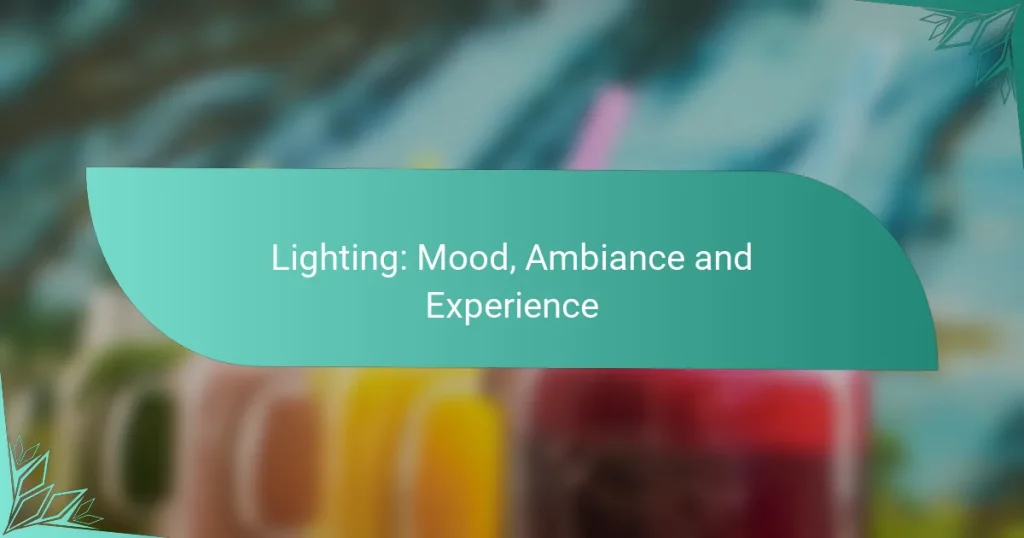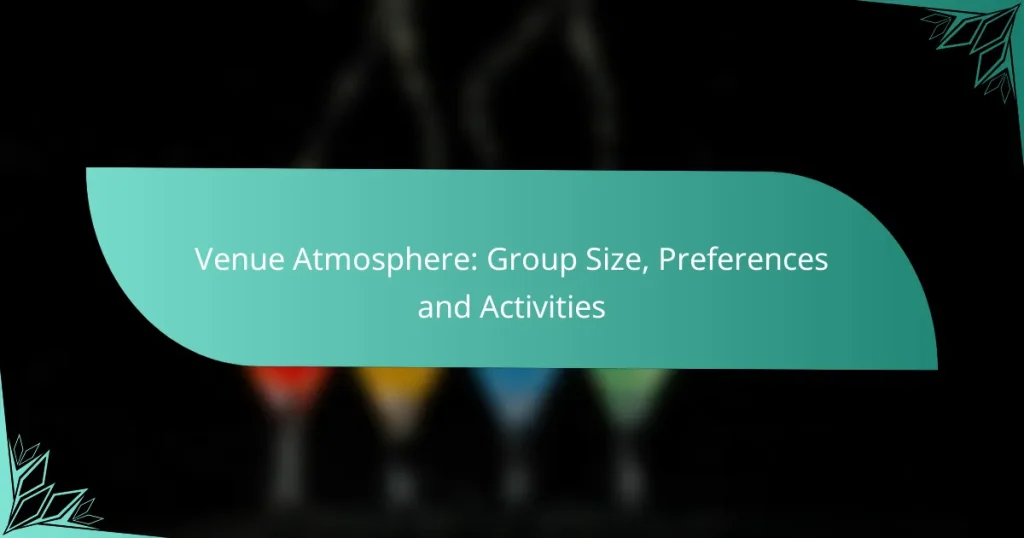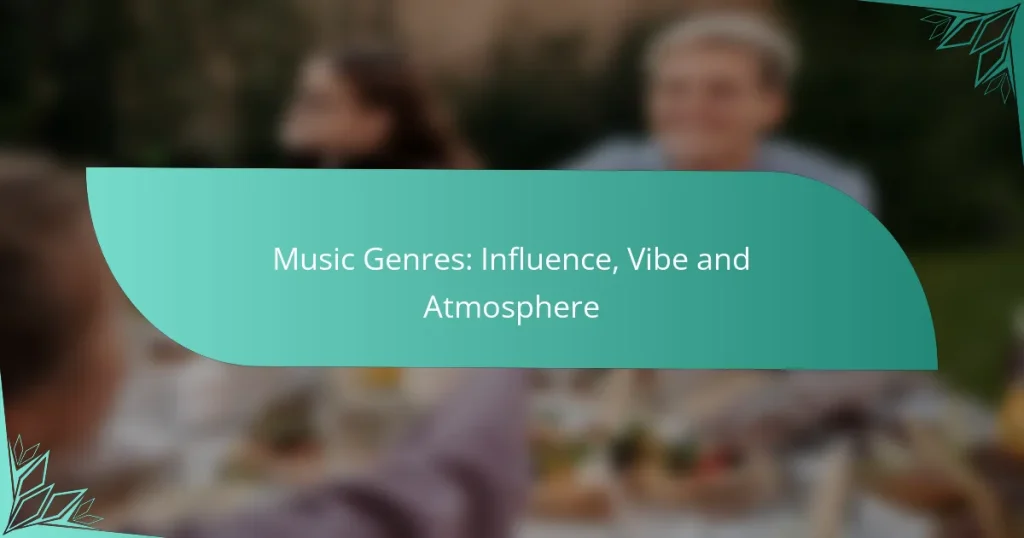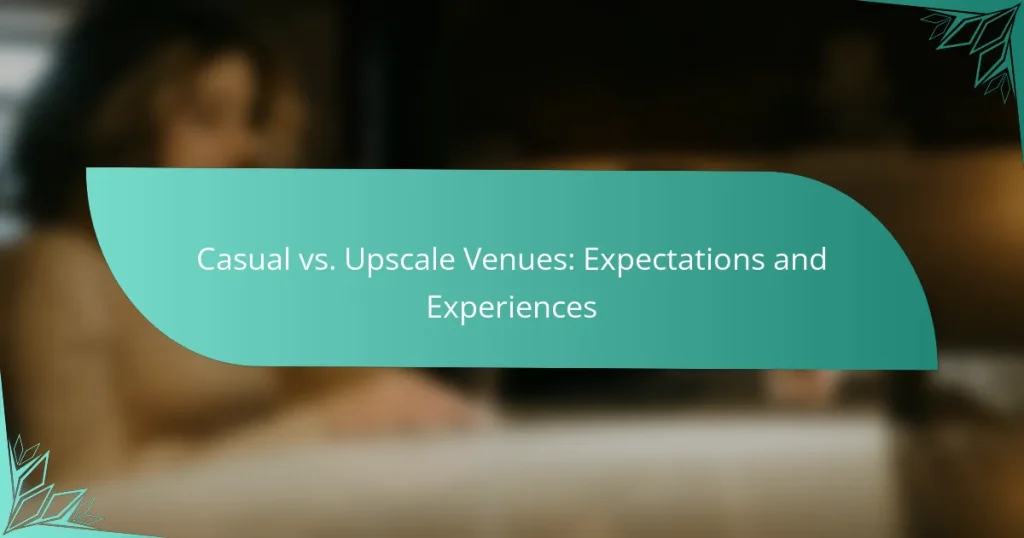The atmosphere of a venue plays a crucial role in shaping customer experiences, particularly in vibrant cities like Los Angeles. By carefully considering elements such as lighting, sound, and decor, venues can craft an inviting ambiance that resonates with their audience, ultimately encouraging repeat visits and positive word-of-mouth. A well-curated environment not only enhances guest interactions but also leaves a lasting impression that defines the overall experience.
Lighting: Mood, Ambiance and Experience
Venue Atmosphere: Group Size, Preferences and Activities
Seasonal Atmosphere: Winter Nights and Venue Selection
Music Genres: Influence, Vibe and Atmosphere
Cultural Influences: Ambiance, Design and Experience
Casual vs. Upscale Venues: Expectations and Experiences
How does venue atmosphere impact customer experience in Los Angeles?
The atmosphere of a venue significantly shapes customer experience in Los Angeles by influencing their emotions and perceptions. A well-designed ambiance can create a memorable experience, encouraging customers to return and recommend the venue to others.
Creates emotional connections
A well-crafted atmosphere fosters emotional connections between customers and the venue. Elements such as lighting, music, and decor can evoke feelings of comfort, excitement, or nostalgia, making patrons feel more engaged. For instance, a cozy, dimly lit restaurant may create a romantic vibe, while a vibrant bar with upbeat music can energize guests.
Consider using local art or themes that resonate with the community to deepen these connections. This approach not only enhances the emotional experience but also supports local artists and businesses.
Influences customer behavior
The venue atmosphere can significantly influence customer behavior, affecting how long they stay and how much they spend. A welcoming environment encourages patrons to linger, often leading to increased orders and higher overall spending. For example, comfortable seating and pleasant background music can prompt customers to enjoy their time longer.
To optimize customer behavior, consider layout and flow. Ensure that seating arrangements promote social interaction and that the atmosphere aligns with the intended experience, whether it’s casual dining or a lively nightlife scene.
Affects repeat business
A positive atmosphere plays a crucial role in driving repeat business. Customers are more likely to return to venues where they felt a strong emotional connection and enjoyed the ambiance. Consistency in maintaining a desirable atmosphere can lead to loyal patrons who choose your venue over competitors.
To encourage repeat visits, regularly assess customer feedback regarding the atmosphere and make adjustments as needed. Simple changes, like updating decor or refreshing the music playlist, can keep the experience exciting and inviting for returning guests.
What are key elements of venue ambiance?
Key elements of venue ambiance include lighting design, sound quality, interior decor, and spatial layout. Each of these factors contributes significantly to the overall experience, influencing how guests perceive and interact with the space.
Lighting design
Lighting design plays a crucial role in setting the mood of a venue. It can create warmth, intimacy, or excitement, depending on the type of event and desired atmosphere. Consider using a combination of ambient, task, and accent lighting to achieve a balanced effect.
For example, soft, warm lights can enhance a romantic dinner setting, while bright, colorful lights may be suitable for a lively party. Dimmer switches and adjustable fixtures allow for flexibility in lighting levels throughout the event.
Sound quality
Sound quality is essential for ensuring that guests can comfortably hear conversations and enjoy music without distortion. Good acoustics can enhance the overall experience, while poor sound can detract from it. Consider using sound-absorbing materials to minimize echo and improve clarity.
Investing in quality audio equipment, such as speakers and microphones, can make a significant difference. Additionally, testing sound levels before the event can help identify and resolve any issues early on.
Interior decor
Interior decor encompasses the visual elements of a venue, including color schemes, furniture, and artwork. Thoughtful decor can create a cohesive theme and enhance the overall ambiance. Choose colors and materials that align with the event’s purpose and target audience.
For instance, a corporate event may benefit from sleek, modern furnishings, while a wedding might call for more romantic elements like floral arrangements and elegant table settings. Regular updates to decor can keep the venue feeling fresh and inviting.
Spatial layout
Spatial layout refers to how the venue is organized and how guests move through the space. A well-planned layout can facilitate interaction and flow, making it easier for guests to navigate the venue. Consider the placement of furniture, stages, and food stations to optimize guest experience.
Ensure there are clear pathways and sufficient space for movement, especially during peak times. Creating distinct zones for different activities can also enhance engagement, such as separating dining areas from entertainment zones.
How can venues enhance their atmosphere?
Venues can enhance their atmosphere by creating a cohesive and inviting environment that resonates with their target audience. This involves thoughtful design choices, sensory elements, and engaging experiences that leave a lasting impression.
Incorporate local art
Integrating local art into a venue’s decor can significantly enhance its atmosphere by fostering a sense of community and cultural connection. Displaying works from local artists not only supports the creative economy but also provides guests with a unique visual experience that reflects the area’s identity.
Consider rotating exhibits or hosting art shows to keep the space dynamic and encourage repeat visits. Collaborating with local art schools or galleries can also provide fresh content and attract art enthusiasts.
Use scent marketing
Scent marketing involves using specific fragrances to create an emotional connection and enhance the overall atmosphere of a venue. Research shows that pleasant scents can increase dwell time and customer satisfaction, making it a powerful tool for venues.
Choose scents that align with your brand and the experience you want to create. For example, a coffee shop might use the aroma of freshly brewed coffee, while a spa could opt for calming lavender. Be mindful of the intensity; subtlety is key to avoid overwhelming guests.
Adjust music volume
Music volume plays a crucial role in shaping the atmosphere of a venue. The right volume can enhance the mood, encourage conversation, and create a welcoming environment, while excessive noise can drive customers away.
Consider the time of day and the type of crowd when adjusting music levels. For instance, lower volumes during dining hours can facilitate conversation, while a livelier atmosphere may call for higher volumes during evening events. Regularly assess guest feedback to find the optimal balance.
What are the costs associated with improving venue ambiance?
Improving venue ambiance involves various costs that can significantly impact your budget. Key expenses include renovation expenses, ongoing maintenance costs, and staff training investments, all of which contribute to creating a more inviting atmosphere for guests.
Renovation expenses
Renovation expenses can vary widely based on the scope of the project, from minor updates to major overhauls. Simple cosmetic changes like new paint or decor might range from a few hundred to several thousand dollars, while structural renovations could exceed tens of thousands. It’s essential to prioritize changes that align with your venue’s brand and guest expectations.
Consider obtaining multiple quotes from contractors to ensure competitive pricing. Additionally, factor in potential downtime during renovations, which could affect revenue if the venue is closed or operating at reduced capacity.
Ongoing maintenance costs
Ongoing maintenance costs are crucial for sustaining the improved ambiance of your venue. Regular upkeep of decor, lighting, and furnishings can range from a few hundred to several thousand dollars annually, depending on the venue’s size and complexity. Establishing a maintenance schedule can help manage these costs effectively.
It’s wise to set aside a percentage of your revenue for maintenance. This proactive approach can prevent larger, unexpected expenses down the line and ensure that the venue remains appealing to guests.
Staff training investments
Investing in staff training is vital for enhancing the overall ambiance through excellent service. Training programs can cost anywhere from a few hundred to several thousand dollars, depending on the depth and duration of the training. Focus on customer service, ambiance awareness, and product knowledge to ensure staff can contribute positively to the guest experience.
Consider implementing regular training sessions to keep staff updated on best practices and new offerings. This ongoing investment not only improves service but also fosters a culture of excellence that reflects positively on the venue’s ambiance.
What are the benefits of a well-designed venue atmosphere?
A well-designed venue atmosphere enhances the overall experience for guests, leading to numerous benefits for both the venue and its clients. Key advantages include increased customer satisfaction, higher event bookings, and an enhanced brand reputation.
Increased customer satisfaction
A pleasing venue atmosphere directly influences customer satisfaction by creating a welcoming and enjoyable environment. Elements such as lighting, decor, and acoustics play a crucial role in setting the mood and making guests feel comfortable.
To maximize satisfaction, consider incorporating personal touches that resonate with your target audience. For instance, using local art or themes can create a sense of connection and enhance the overall experience.
Higher event bookings
A captivating venue atmosphere can significantly boost event bookings. When potential clients visit a space that feels inviting and well-designed, they are more likely to envision their own events taking place there.
To attract more bookings, showcase your venue’s unique features through high-quality photos and virtual tours. Offering flexible packages that cater to different types of events can also appeal to a broader range of clients.
Enhanced brand reputation
A well-crafted venue atmosphere contributes to a positive brand reputation, as satisfied customers are more likely to share their experiences. Word-of-mouth recommendations and online reviews can greatly influence potential clients’ perceptions of your venue.
To build a strong brand reputation, consistently deliver exceptional service and maintain the venue’s aesthetic appeal. Engaging with customers on social media and responding to feedback can further enhance your venue’s image in the community.
What are common mistakes in venue ambiance design?
Common mistakes in venue ambiance design include poor lighting choices and ignoring acoustics. These elements significantly impact the overall experience, affecting comfort and engagement levels for guests.
Poor lighting choices
Poor lighting can create an unwelcoming atmosphere or hinder visibility. It’s essential to balance ambient, task, and accent lighting to enhance the venue’s character while ensuring functionality.
Consider using dimmable lights to adjust the mood based on the time of day or event type. For example, softer lighting works well for intimate gatherings, while brighter lights may be necessary for conferences or workshops.
Avoid relying solely on overhead fluorescent lights, as they can create harsh shadows and an uninviting feel. Instead, incorporate a mix of light sources, such as table lamps or wall sconces, to create a warm and inviting ambiance.
Ignoring acoustics
Ignoring acoustics can lead to excessive noise levels or poor sound quality, detracting from the guest experience. Proper acoustic design helps control sound reflections and absorption, ensuring clear communication and a pleasant environment.
When designing a venue, consider materials that absorb sound, such as carpets, curtains, and acoustic panels. These can help reduce echo and background noise, making conversations easier and more enjoyable.
Additionally, be mindful of the venue layout. Open spaces may require strategic placement of sound-absorbing elements to minimize noise distractions. Regularly assess the sound environment during events to identify areas for improvement.
